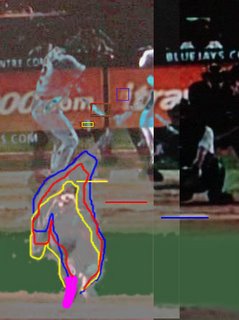I’ve taken such a long hiatus from this blog because, among other reasons, it’s hard to find something interesting and unique about the M’s these days. The guys at USSMariner and Lookout Landing are my regular reading, and the rest of the blogosphere gives some great perspectives, too.
But another reason I’ve been silent is that I usually like to address a problem with a solution. The Mariners’ problems have been well-documented by the aforementioned bloggers: an organizational approach to player development that discourages a patient, disciplined approach to hitting, a manager prone to obviously ridiculous decisions, poor starting pitching, underperformance by players expected to excel.
Identifying these problems are a good beginning, and it’s most frustrating as a fan to hear and see things from the organization that suggest they aren’t even aware of the magnitude, or even the existence, of some of these problems.
As we head into the off-season, though, simply identifying problems—pointing out actions to avoid—won’t provide a plan for what actions to take. It’s the classic role of the armchair GM: point out the foibles of the existing regime without suggesting a plausible course of action.
For example: most bloggers are pretty tired of Mike Hargrove’s shenanigans. Time and again, he
employs strategies that
work against his players’ strengths,
routinely botches the management of his bullpen, and
ignores plains facts. But what are the realistic alternatives? Hargrove himself is a replacement for incompetence, if you can remember far enough back to the Bob Melvin days. I’d love to see Tacoma’s Dan Rohn succeed, but I’m not sure there’s any guarantee that Rohn will be any better. Rohn’s predecessor, Dave Myers, had great success in Tacoma but bombed as a third base coach here. The point is, I think there's a good chance that a Hargrove replacement won't be much better than Grover himself.
Most recently, Dave Cameron reminds us that
long-term contracts for veteran pitchers are a bad idea. We all know that the Mariner’s rotation is terrible. Optimists at the beginning of the season saw Joel Pineiro returning to his early success, Felix blowing everybody away, and Washburn serving as a serviceable innings-eater. That hasn’t worked out so well. Many fans are chomping at the bit for some big acquisitions, and Dave says that we’re more likely to be snakebit than strike it rich.
There are two problems with his critique: first, the free agent market isn’t linear, especially for pitchers. To get top quality talent, you have to pay a premium, above and beyond the market rate for pitching. Nate Silver
demonstrated this a few years back at Baseball Prospectus, and Jeff
did his own analysis at lookout landing a year later. Nate Silver’s graph illustrates how much more premium pitching costs. Contracts for premium pitching are nearly always going to look exorbitant, so in general, you can either “overpay” for pitching (in terms of dollars, duration, or both), or you let premier talent on the free agent market go to the teams that will.
There are some exceptions, of course, which is where Dave wants the team to look. Find the pitcher that won’t take a huge bite out of your payroll for five years straight, but that will help make your team a winner.
This is, of course, easier said than done. I’m not here to pick on Dave Cameron, but he has put forward a proposed plan for the offseason the last several years, and his plans are evidence of just how hard it is to find reasonably priced effective pitching talent. For example, last year, he wanted the team to go after A.J. Burnett. Now? His current contract “doesn’t look so hot” to Dave. He also advocated for Esteban Loaiza and Kevin Brown, neither of whom have impressed (though Loaiza, as it happens with the A’s every season, has looked strong in the second half). The previous year, Dave suggested Matt Clement, who for signed for only three years but has been a disappointment this year as well.
Certainly, long-term contracts for veteran pitchers are a very risky endeavor, with more failures than successes. But good alternatives are hard to find, and I don’t see the difference between having the same mediocre pitcher on your roster for five years, versus three mediocre pitchers in those same five years. If avoiding long-term contracts allows you to buy short-term mediocrity, you haven’t accomplished much.
Now, there are bad long-term contracts, including one Jarrod Washburn, whom Dave rightly predicted would be a poor choice. Washburn is not only an albatross on the payroll, he likely will never be a good pitcher for the M’s. But avoiding bad long-term contracts is not the same as categorically ruling them out.
Update: I won't flatter myself by suggesting that Dave Cameron read my post here and decided to respond, but I will give him credit for following up his first post with a concrete suggestion: read it here.





